when your most anticipated release leaves you in a reading slump
november bookmarks, books read and bought
Any Sally Rooney girlies out there?
Two authors are on my auto-buy list: Leigh Bardugo and Sally Rooney. I know — very different vibes, but they perfectly encapsulate my reading taste: fantasy and contemporary fiction.
However, my journey with Rooney didn’t start smoothly. I picked up Conversations with Friends on a whim from a charity shop in January 2019, and it was… okay. The story, the characters — I don’t remember much if I’m honest. Fast forward a year (almost to the day), and I decided to give Normal People a go. I devoured it in three days. What does that say about me? Let’s not get into it.
Since then, picking up whatever Sally Rooney gives us has become routine. Her characters always feel unflinchingly real as if they have lives of their own. They’re flawed, messy, and unlikeable. But aren’t we all? Her writing always leaves me pondering life in one way or another.
This time, I was particularly looking forward to Intermezzo. It felt like a departure from her usual female and male protagonist dynamic. Here, the story begins with two brothers, each grieving the loss of their father in their own way. But it hasn’t quite gripped me yet, and I’ve set it aside for now. It probably doesn’t help that I’ve only dipped into it during my 20-minute breaks at work. I suspect it deserves a longer, more immersive reading experience.
I’ve heard it picks up in the second part, so I plan to finish it in December and share my thoughts then. No review of Intermezzo for now, but I hope you’ll still find inspiration in the books below — the ones that helped pull me out of my slump!
books i read
Graveyard Shift by M.L. Rio
I first encountered M.L. Rio’s writing with If We Were Villains, one of the more recent campus/dark academia books often compared to The Secret History by Donna Tartt. I found it to be everything I wanted The Secret History to be—perhaps a controversial take that might cost me a couple of readers, but I stand by it. Naturally, I was eager to read Rio’s novella, Graveyard Shift. Yet, when it was published in September, I held back, saving it for spooky season. That decision paid off, as I got to attend the author’s book tour at Topping & Company in Edinburgh.
Graveyard Shift is a tightly crafted novella spanning 10 chapters over a hundred pages, covering the hours between midnight and 10 a.m. Some readers might wish it were longer or feel dissatisfied with the ending. For me, it delivered exactly what I was hoping for.
The premise is simple yet intriguing: One dark October evening in an abandoned churchyard, they discover a hole that wasn’t there before—a freshly dug grave where no grave should be. But who dug it, and for whom? That’s really all you need to know going in.
The structure, with chapters marked by the passing hours, felt almost like a play, adding a sense of excitement. The story moves between different characters, creating a bingeable, almost breathless pace. You quickly become invested, feeling like you’re part of the gang—a group of intriguing characters, neither entirely likeable nor dislikable, just real people looking for a thrill past midnight. During the book talk, M.L. Rio described Graveyard Shift as a “bad episode of Scooby-Doo,” and when a character says, “Let’s think, who’s up at this hour and would just jump at the chance to join Mystery Inc.?” all I wanted to do was put on an orange jumper or some purple boots and join the hunt.
The cherry on top? The campus setting. I’m a sucker for campus novels, and this one, with its creepy cover art, dead rats, and disgusting mushrooms, hooked me from start to finish. The ending? Perfectly fitting for a novella, leaving you both satisfied and wanting more, with just enough ambiguity to ponder over. The perfect read for a chilly night, preferably by candlelight.
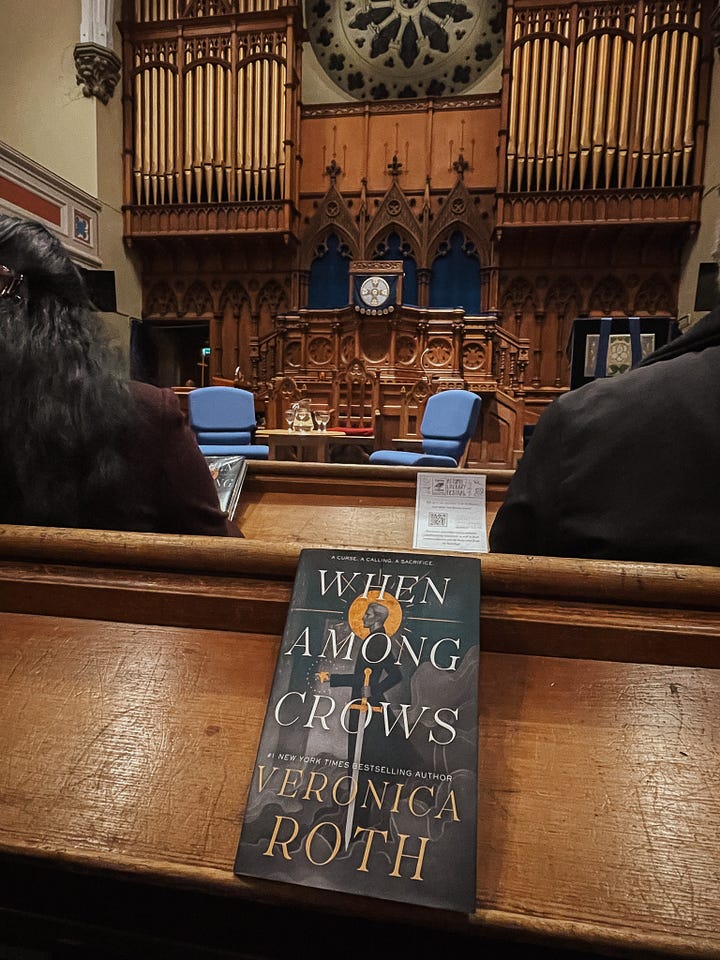
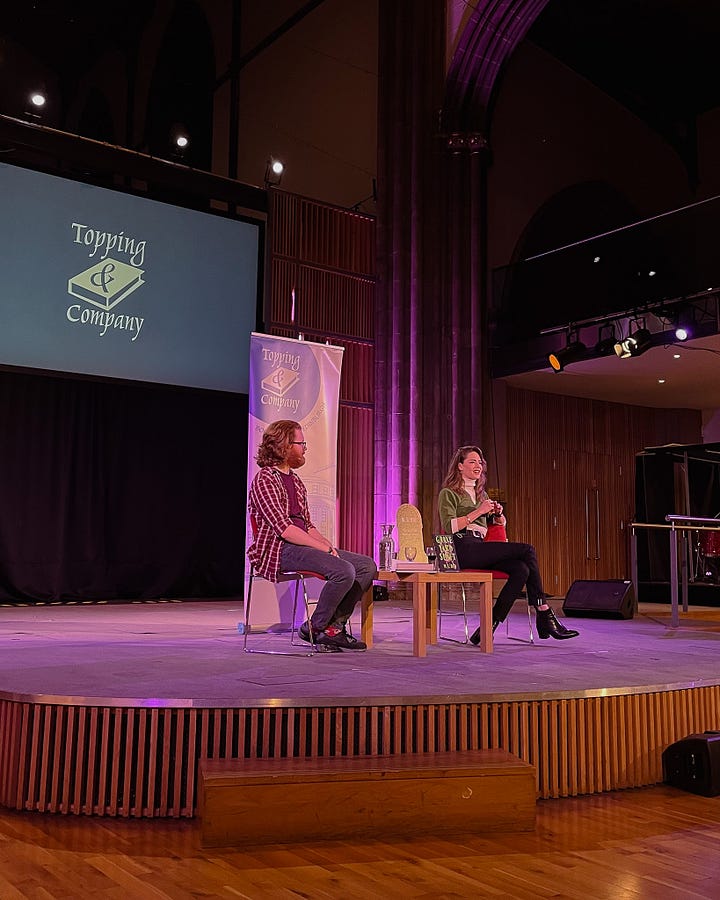
Then I went on a T. Kingfisher tangent, courtesy of Libby (my library app).
What Moves the Dead by T. Kingfisher
Apparently, I hadn’t had my fill of mushrooms yet because, after Graveyard Shift, I picked up What Moves the Dead—my first T. Kingfisher book. Given Kingfisher’s extensive backlist and reputation as the queen of dark retellings, I wasn’t sure where to start, but this seemed like the perfect entry point. What Moves the Dead is a haunting, atmospheric retelling of Edgar Allan Poe’s The Fall of the House of Usher. I haven’t read the original yet, but I’m considering it after this.
The audiobook was an experience in itself—the grotesque descriptions made the hair on my arms stand on end. And if you’ve read it, you’ll understand why it was particularly unsettling. Truly, this book is a fungal feast for the senses, blending horror and atmosphere with Kingfisher’s unique voice.
What Feasts at Night by T. Kingfisher
After finishing What Moves the Dead, I eagerly jumped into the sequel, What Feasts at Night, the second book in the Sworn Soldier duology. It wasn’t quite what I expected, though. While the first book was atmospheric and spine-chilling, this one leaned more into humour and felt slower-paced. It didn’t grip me in the same way, but it was still an enjoyable read, albeit less gruesome. Perhaps “enjoyable” isn’t the best word when talking about monstrous nightmares, but you get what I mean.
Thornhedge by T. Kingfisher
This one felt a bit short and quite different from the other two. Thornhedge is still described as horror on Goodreads, but the horror element is rather brief. You won’t get the goosebumps you might from What Moves the Dead or What Feasts at Night. Instead, it’s rather cute — more of a twisty fairytale than anything truly terrifying.
If I Don’t Know by Wendy Cope
Reading poetry is truly an art. Finding harmony in the words, feeling the rhythm, and understanding how they sing together can evoke strong emotions or inspire deep reflection. I've been trying to get into poetry for some time, but I often find it challenging. My native language is French, and as I live in the UK, nearly all the books I read are in English. Sometimes, reading poetry in English feels like being back at school, puzzling over verses and prose. I recognise the words, and understand their meanings, but often don’t quite feel them.
Then, once in a while, I come across a collection that speaks to me — and If I Don’t Know was one of those rare finds. Wendy Cope’s poems are light-hearted, gritty, funny, and thought-provoking, and this time, I got it.
Permafrost by Eva Baltasar
Have you ever borrowed a book from the library thinking, I don’t want to spend money — I’m not even sure I’ll like this; it’s not really my style anyway? Then, as you start reading, find yourself wanting desperately to grab your ruler and pencil to annotate the hell out of it. That was me with Permafrost. I picked it up initially because the narrator, who is from Barcelona, had lived in Scotland and Belgium — places that resonate with me. But that’s just the backdrop; there’s so much more to it.
The narrative is chaotic, not linear, but rather like a series of short vignettes. Yet, as a whole, it works beautifully, giving you a glimpse into the narrator’s mind. Eva Baltasar, a poet by trade, fills her writing with rich imagery and poetic language. It’s both inspiring and deeply resonant. I have no doubt this book will soon have a permanent place on my shelves — and the same goes for the rest of the Tríptic series.
When Among Crows by Veronica Roth
As I mentioned in my november review, I attended two book talks: one with M.L. Rio (mentioned earlier) and another with Veronica Roth. I had read When Among Crows in May, not long after its release, and absolutely loved it. It’s a novella—just 166 pages—and takes place over 36 hours. Despite its short length, Veronica Roth crafted an intricate world that some authors struggle to achieve in 500-page bricks.
The story is an urban fantasy rooted in Slovak and Polish folklore, set in Chicago. The Polish folklore element particularly spoke to me, as my dad is Polish and moved to Belgium when he was about 12. He set aside his heritage, and my only connection to Poland was through my grandmother’s cooking. This resonated with me, as one of the characters in When Among Crows shares a similar experience, as does Veronica Roth herself.
Anyway, back to the story. It follows an unlikely trio on a quest—a simple premise, but executed so well. After attending the event, I felt inspired to revisit the book, especially after hearing her speak about her inspirations. She shared her connection to Chicago, how her heritage led her to Polish folklore, and how she adapted these elements naturally and authentically. Five months after my first read, I realised I’d forgotten the ending, and it surprised me all over again.
Roth also recommended two books for fans of Slovak folklore: Spinning Silver by Naomi Novik and The Bear and the Nightingale by Katherine Arden. I listened to both in November. While they didn’t resonate with me quite as much as When Among Crows (as they lean more towards a young adult fan base), I could see the inspirations. They’ve sparked my curiosity to explore more books inspired by these myths.
If you have any recommendations for similar folklore-inspired reads, please send them my way!
books i bought
Graveyard Shift by M.L. Rio
Acquired and signed at the M.L. Rio x Toppings event, this is now one of my prized possessions.
The White Book by Han Kang
The White Book was the only translated work by Han Kang missing from my collection! I read a library copy some time ago, and I’m excited to now own it so I can reread it and underline my favourite poems.
Bone Black by bell hooks
I’ve yet to read All About Love (it’s on my December TBR), but when I visited the Edinburgh Radical Book Fair, I couldn’t resist picking this one up. My plan at the fair was to be disciplined: one nonfiction and one fiction book. It wasn’t easy to stick to just one nonfiction title, but Bone Black felt like the perfect choice, promising to explore themes that deeply interest me.
Welcome to Dorley Hall by Alyson Greaves
This was the fiction book I settled on. It seems wonderfully dark, set on a campus, and is queer — that’s all I needed to know!


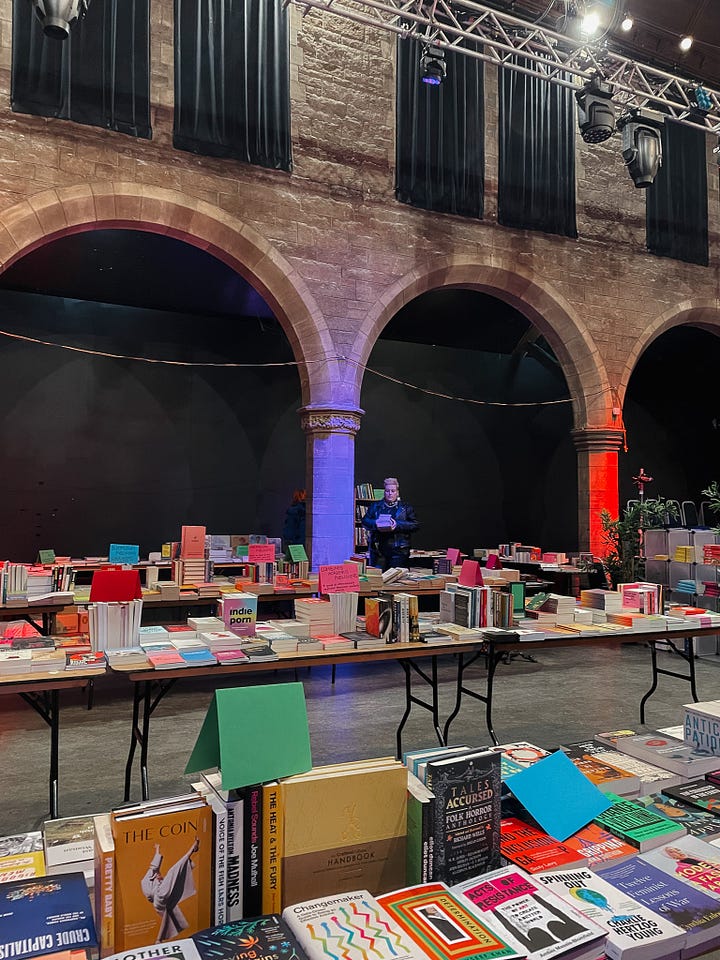
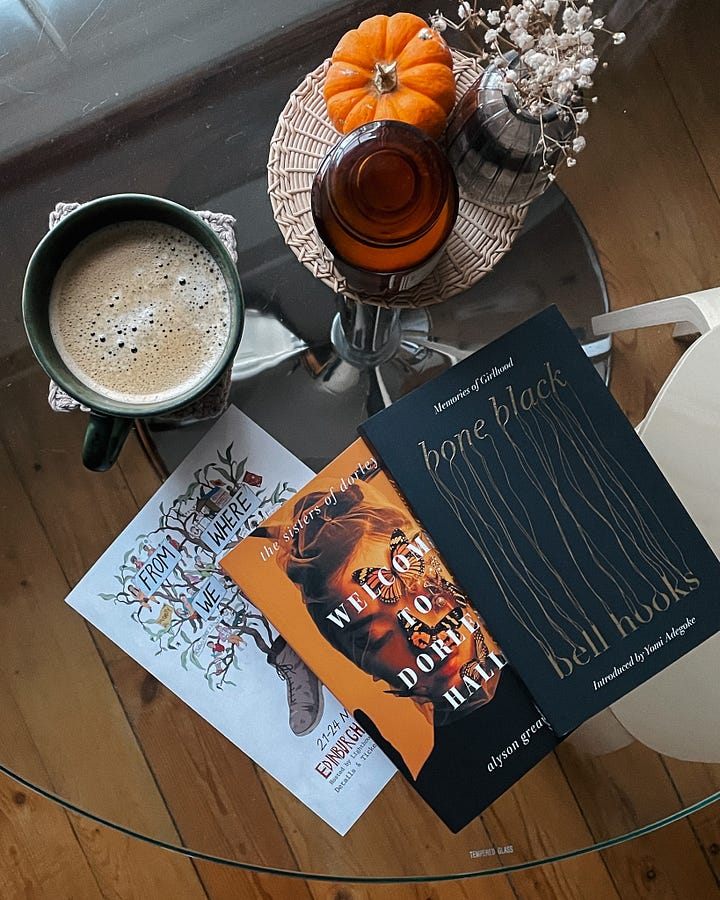
Some second-hand gems:
If I Don't Know by Wendy Cope
La Place (en: A Man's Place) by Annie Ernaux
The Bell Jar by Sylvia Plath
Perfume by Patrick Süskind
The last three are actually planned re-reads. I first came across The White Book as a library loan, and I’m thrilled to finally have my copy to annotate. There seems to be a theme here — I also picked up a second-hand copy of The Bell Jar, one of my all-time favourite modern classics, to revisit and add my own notes (I already own two copies, but they’re far too precious for it).
As for Perfume, I read it as a school assignment at 15 or 16. Honestly, my strongest memory of it is just how unsettling it was! Now that I’m older, I’m curious to see if its twisted narrative hits differently.
Have you read any of these? I’d love to hear your thoughts or hear about the favourite books you read this November!
See you in the next one ♡
Amandine
☕ if you'd like to support my writing, you can do so here—thank you! xx





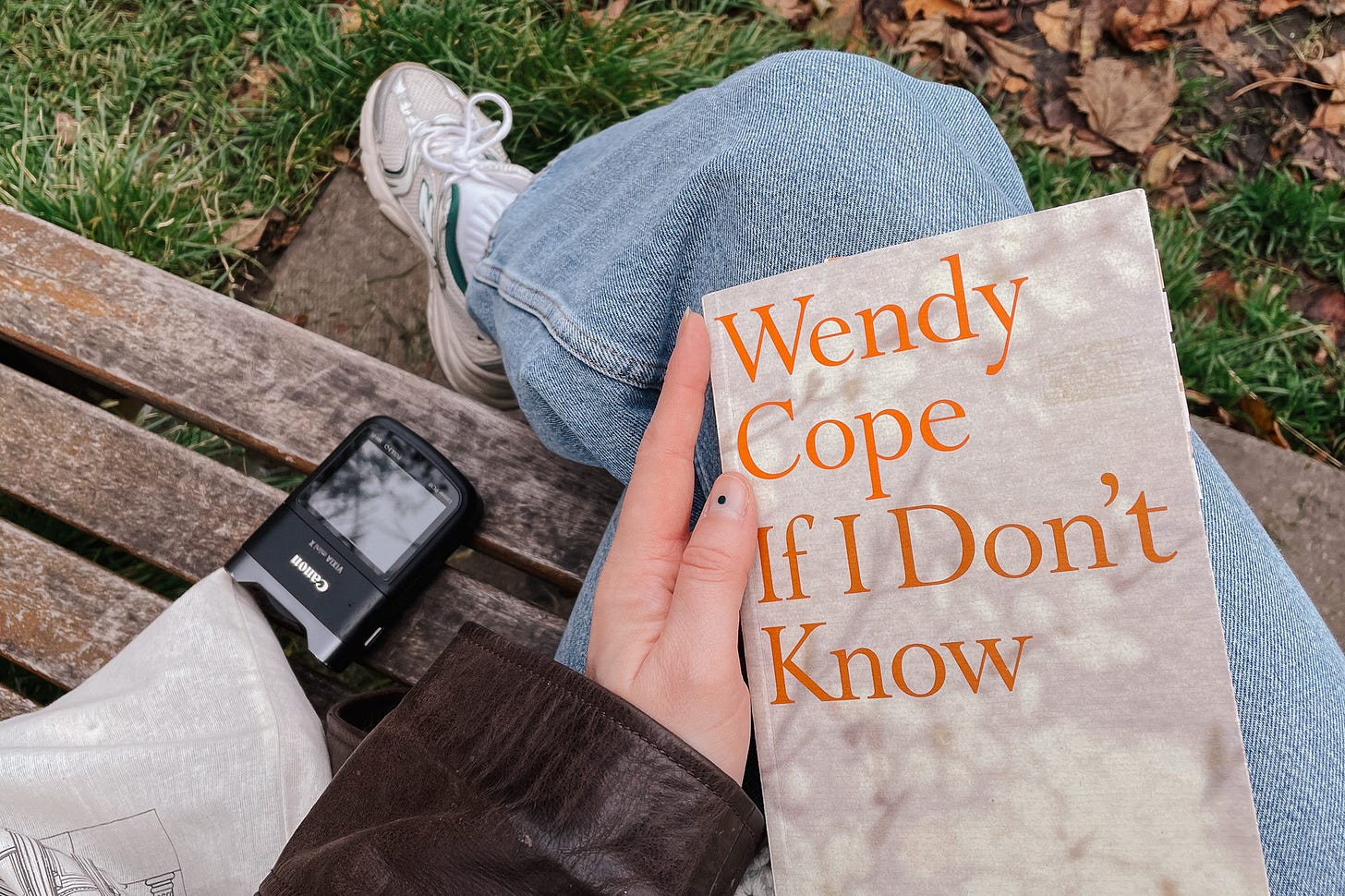
Je n’ai lu qu’un poème de Wendy Cope, Lonely Hearts, que j’ai dû adapter en court-métrage quand j’étais à la fac. C’est peut-être un signe pour que je lise d’autres poèmes d’elle. Je n’ai lu aucun livre de ton recap, mais les livres de M.L Rio me tentent beaucoup. Le Parfum, je l’avais lu quand j’étais ado il me semble, je me souviens avoir trouvé ça bizarre mais j’avais bien aimé. Comme toi, ça serait intéressant que je le relise. Mon mois de novembre n’était pas fameux, des lectures correctes mais pas fantastiques, mis à part Billie Pretty a disparu de Sophie Astrabie que j’ai adoré. J’espère que j’aurai de meilleures lectures ce mois-ci 😊